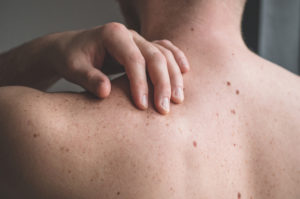Understanding the Moles on your Skin
 Do you have moles on your skin? Most people do! Moles are a very common type of skin growth, just small, dark brown spots caused by clusters of pigmented cells. In fact, the average person has between 10 and 40 moles! Most of the time, moles are harmless. Sometimes, however, they become cancerous. This is rare, but it underscores the importance of monitoring moles and other pigment patches so that if there is something wrong, you’ll detect it early.
Do you have moles on your skin? Most people do! Moles are a very common type of skin growth, just small, dark brown spots caused by clusters of pigmented cells. In fact, the average person has between 10 and 40 moles! Most of the time, moles are harmless. Sometimes, however, they become cancerous. This is rare, but it underscores the importance of monitoring moles and other pigment patches so that if there is something wrong, you’ll detect it early.
How much do you know about moles? The medical term for them is nevi, and they can come in many different sizes and shapes. They occur when cells in the skin, known as melanocytes, grow in clumps or clusters. Moles can be pink, red, blue, black, tan, or brown. They might be smooth, or they may be wrinkled. Some moles have hair growing from them. Moles tend to be oval or round, and most of them are less than ¼ inch in diameter. That’s about the size of a pencil eraser. Moles can develop anywhere, and may turn up on your scalp, in your armpits, between your fingers and toes, and even under your nails. Most people have between 10 and 40 moles, and most moles develop by age 50. They can change in appearance or even fade away, but there are a few warning signs you should look for, to make sure a mole isn’t becoming dangerous.
It’s important to know your own skin, so that you will be aware of any unusual, or atypical moles. Atypical moles have irregular features under a microscope, and are at an increased risk for melanoma, a dangerous skin cancer. Atypical moles can occur anywhere on the body, and an easy way to remember how to recognize an atypical mole that may be a melanoma is to think “ABCDE”.
- A is for asymmetry. The two halves of a melanoma won’t match each other.
- B is for borders. A mole with an irregular, scalloped, or notched border may be a melanoma.
- C is for colorful. Pay attention to moles that have changed color or are multicolored.
- D is for both dark and diameter. A mole larger than a pencil eraser or darker than your other moles could be dangerous.
- E is for evolving. Look for changes in size, shape, color or height, or symptoms like bleeding, itching, or crusting.
Any mole that seems suspicious warrants immediate medical attention. If you’re looking for a dermatologist, Swinyer-Woseth Dermatology is committed to providing professional skin care in a manner that’s practical, efficient, and compassionate. With over 30 years of experience providing dermatological services in Salt Lake City, we provide a variety of services, from cosmetic skincare to treatment for skin cancer. Our team of board-certified dermatologists, licensed cosmetic service providers, and friendly staff members are here to provide the care you need in a comfortable, professional atmosphere. For more information, contact us through our website or call (801) 682-4715.
